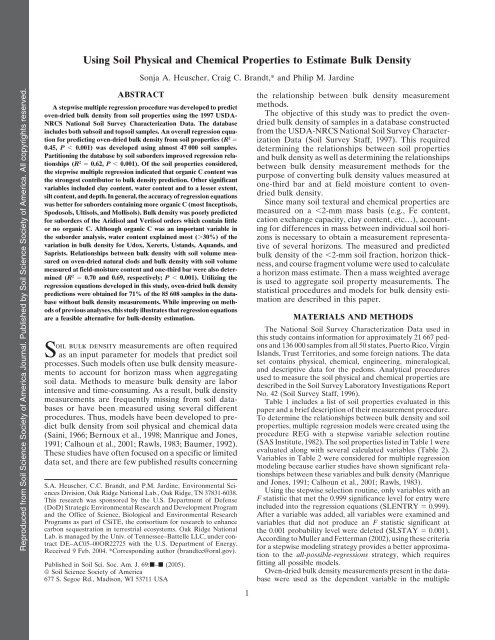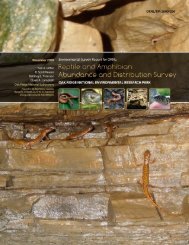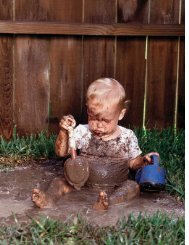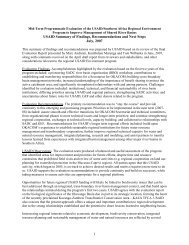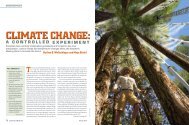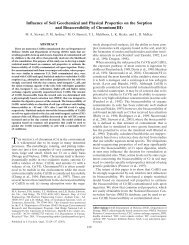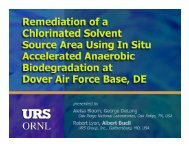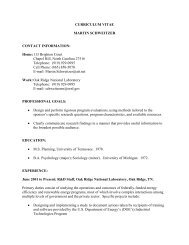Using Soil Physical and Chemical Properties to Estimate Bulk Density
Using Soil Physical and Chemical Properties to Estimate Bulk Density
Using Soil Physical and Chemical Properties to Estimate Bulk Density
Create successful ePaper yourself
Turn your PDF publications into a flip-book with our unique Google optimized e-Paper software.
<strong>Using</strong> <strong>Soil</strong> <strong>Physical</strong> <strong>and</strong> <strong>Chemical</strong> <strong>Properties</strong> <strong>to</strong> <strong>Estimate</strong> <strong>Bulk</strong> <strong>Density</strong><br />
Sonja A. Heuscher, Craig C. Br<strong>and</strong>t,* <strong>and</strong> Philip M. Jardine<br />
Reproduced from <strong>Soil</strong> Science Society of America Journal. Published by <strong>Soil</strong> Science Society of America. All copyrights reserved.<br />
ABSTRACT<br />
the relationship between bulk density measurement<br />
A stepwise multiple regression procedure was developed <strong>to</strong> predict methods.<br />
oven-dried bulk density from soil properties using the 1997 USDAdried<br />
bulk density of samples in a database constructed<br />
The objective of this study was <strong>to</strong> predict the oven-<br />
NRCS National <strong>Soil</strong> Survey Characterization Data. The database<br />
includes both subsoil <strong>and</strong> <strong>to</strong>psoil samples. An overall regression equation<br />
from the USDA-NRCS National <strong>Soil</strong> Survey Character-<br />
for predicting oven-dried bulk density from soil properties (R 2 ization Data (<strong>Soil</strong> Survey Staff, 1997). This required<br />
0.45, P 0.001) was developed using almost 47 000 soil samples. determining the relationships between soil properties<br />
Partitioning the database by soil suborders improved regression rela- <strong>and</strong> bulk density as well as determining the relationships<br />
tionships (R 2 0.62, P 0.001). Of the soil properties considered, between bulk density measurement methods for the<br />
the stepwise multiple regression indicated that organic C content was<br />
purpose of converting bulk density values measured at<br />
the strongest contribu<strong>to</strong>r <strong>to</strong> bulk density prediction. Other significant<br />
one-third bar <strong>and</strong> at field moisture content <strong>to</strong> ovenvariables<br />
included clay content, water content <strong>and</strong> <strong>to</strong> a lesser extent,<br />
silt content, <strong>and</strong> depth. In general, the accuracy of regression equations dried bulk density.<br />
was better for suborders containing more organic C (most Inceptisols, Since many soil textural <strong>and</strong> chemical properties are<br />
Spodosols, Ultisols, <strong>and</strong> Mollisols). <strong>Bulk</strong> density was poorly predicted measured on a 2-mm mass basis (e.g., Fe content,<br />
for suborders of the Aridisol <strong>and</strong> Vertisol orders which contain little cation exchange capacity, clay content, etc…), account-<br />
or no organic C. Although organic C was an important variable in ing for differences in mass between individual soil horithe<br />
suborder analysis, water content explained most (30%) of the zons is necessary <strong>to</strong> obtain a measurement representavariation<br />
in bulk density for Udox, Xererts, Ust<strong>and</strong>s, Aqu<strong>and</strong>s, <strong>and</strong> tive of several horizons. The measured <strong>and</strong> predicted<br />
Saprists. Relationships between bulk density with soil volume mea- bulk density of the 2-mm soil fraction, horizon thicksured<br />
on oven-dried natural clods <strong>and</strong> bulk density with soil volume ness, <strong>and</strong> course fragment volume were used <strong>to</strong> calculate<br />
measured at field-moisture content <strong>and</strong> one-third bar were also detera<br />
horizon mass estimate. Then a mass weighted average<br />
mined (R 2 0.70 <strong>and</strong> 0.69, respectively; P 0.001). Utilizing the<br />
is used <strong>to</strong> aggregate soil property measurements. The<br />
regression equations developed in this study, oven-dried bulk density<br />
predictions were obtained for 71% of the 85 608 samples in the datamation<br />
are described in this paper.<br />
statistical procedures <strong>and</strong> models for bulk density esti-<br />
base without bulk density measurements. While improving on methods<br />
of previous analyses, this study illustrates that regression equations<br />
are a feasible alternative for bulk-density estimation.<br />
MATERIALS AND METHODS<br />
The National <strong>Soil</strong> Survey Characterization Data used in<br />
S<br />
this study contains information for approximately 21 667 pedons<br />
<strong>and</strong> 136 000 samples from all 50 states, Puer<strong>to</strong> Rico, Virgin<br />
oil bulk density measurements are often required<br />
as an input parameter for models that predict soil Isl<strong>and</strong>s, Trust Terri<strong>to</strong>ries, <strong>and</strong> some foreign nations. The data<br />
processes. Such models often use bulk density measure<strong>and</strong><br />
descriptive data for the pedons. Analytical procedures<br />
set contains physical, chemical, engineering, mineralogical,<br />
ments <strong>to</strong> account for horizon mass when aggregating<br />
used <strong>to</strong> measure the soil physical <strong>and</strong> chemical properties are<br />
soil data. Methods <strong>to</strong> measure bulk density are labor<br />
described in the <strong>Soil</strong> Survey Labora<strong>to</strong>ry Investigations Report<br />
intensive <strong>and</strong> time-consuming. As a result, bulk density No. 42 (<strong>Soil</strong> Survey Staff, 1996).<br />
measurements are frequently missing from soil data- Table 1 includes a list of soil properties evaluated in this<br />
bases or have been measured using several different paper <strong>and</strong> a brief description of their measurement procedure.<br />
procedures. Thus, models have been developed <strong>to</strong> pre- To determine the relationships between bulk density <strong>and</strong> soil<br />
dict bulk density from soil physical <strong>and</strong> chemical data properties, multiple regression models were created using the<br />
(Saini, 1966; Bernoux et al., 1998; Manrique <strong>and</strong> Jones, procedure REG with a stepwise variable selection routine<br />
1991; Calhoun et al., 2001; Rawls, 1983; Baumer, 1992). (SAS Institute, 1982). The soil properties listed in Table 1 were<br />
These studies have often focused on a specific or limited evaluated along with several calculated variables (Table 2).<br />
Variables in Table 2 were considered for multiple regression<br />
data set, <strong>and</strong> there are few published results concerning<br />
modeling because earlier studies have shown significant relationships<br />
between these variables <strong>and</strong> bulk density (Manrique<br />
S.A. Heuscher, C.C. Br<strong>and</strong>t, <strong>and</strong> P.M. Jardine, Environmental Sci<strong>and</strong><br />
Jones, 1991; Calhoun et al., 2001; Rawls, 1983).<br />
ences Division, Oak Ridge National Lab., Oak Ridge, TN 37831-6038. <strong>Using</strong> the stepwise selection routine, only variables with an<br />
This research was sponsored by the U.S. Department of Defense F statistic that met the 0.999 significance level for entry were<br />
(DoD) Strategic Environmental Research <strong>and</strong> Development Program included in<strong>to</strong> the regression equations (SLENTRY 0.999).<br />
<strong>and</strong> the Office of Science, Biological <strong>and</strong> Environmental Research After a variable was added, all variables were examined <strong>and</strong><br />
Programs as part of CSiTE, the consortium for research <strong>to</strong> enhance variables that did not produce an F statistic significant at<br />
carbon sequestration in terrestrial ecosystems. Oak Ridge National the 0.001 probability level were deleted (SLSTAY 0.001).<br />
Lab. is managed by the Univ. of Tennessee–Battelle LLC, under con- According <strong>to</strong> Muller <strong>and</strong> Fetterman (2002), using these criteria<br />
tract DE–AC05–00OR22725 with the U.S. Department of Energy.<br />
for a stepwise modeling strategy provides a better approxima-<br />
Received 9 Feb. 2004. *Corresponding author (br<strong>and</strong>tcc@ornl.gov).<br />
tion <strong>to</strong> the all-possible-regressions strategy, which requires<br />
Published in <strong>Soil</strong> Sci. Soc. Am. J. 69:– (2005).<br />
fitting all possible models.<br />
© <strong>Soil</strong> Science Society of America<br />
Oven-dried bulk density measurements present in the data-<br />
677 S. Segoe Rd., Madison, WI 53711 USA base were used as the dependent variable in the multiple<br />
1
2 SOIL SCI. SOC. AM. J., VOL. 69, JANUARY–FEBRUARY 2005<br />
Reproduced from <strong>Soil</strong> Science Society of America Journal. Published by <strong>Soil</strong> Science Society of America. All copyrights reserved.<br />
Table 1. Description of parameters evaluated for inclusion in the simple <strong>and</strong> multiple regression models used in the estimation of<br />
bulk density.<br />
Parameter name<br />
<strong>Bulk</strong> density, oven dry<br />
<strong>Bulk</strong> density, 1/3 bar<br />
<strong>Bulk</strong> density,<br />
field moisture content<br />
clay<br />
silt<br />
s<strong>and</strong><br />
c_org<br />
wc<br />
depth<br />
Description<br />
<strong>Bulk</strong> density, 2-mm soil fabric, with soil volume measured by coating natural clods in plastic then weighing the<br />
oven-dried clod in air <strong>and</strong> water <strong>to</strong> obtain its volume by Archimedes’ principle. <strong>Bulk</strong> density is calculated by<br />
dividing the weight of the oven dried clod by this volume. (g cm 3 )<br />
<strong>Bulk</strong> density, 2-mm soil fabric, with soil volume measured by coating natural clods in plastic then weighing the<br />
clod at one-third bar tension in air <strong>and</strong> water <strong>to</strong> obtain its volume by Archimedes’ principle. <strong>Bulk</strong> density is<br />
calculated by dividing the weight of the oven-dried clod by this volume. (g cm 3 )<br />
<strong>Bulk</strong> density, 2-mm soil fabric, with soil volume measured by coating natural clods in plastic then weighing the<br />
clod at field moisture content in air <strong>and</strong> water <strong>to</strong> obtain its volume by Archimedes’ principle. <strong>Bulk</strong> density is<br />
calculated by dividing the weight of the oven-dried clod by this volume. (g cm 3 )<br />
Total clay content of the 2-mm fabric, the soil separate with 0.002-mm particle diameter, determined with the<br />
Kilmer <strong>and</strong> Alex<strong>and</strong>er pipette method. Clay-size carbonate is included. (% weight)<br />
Total silt content of the 2-mm soil fabric, soil separate with 0.002- <strong>to</strong> 0.05-mm particle diameter, determined with<br />
the Kilmer <strong>and</strong> Alex<strong>and</strong>er pipette method. (% weight)<br />
Total s<strong>and</strong> content of the 2-mm soil fabric, the soil separate with 0.05- <strong>to</strong> 2.0-mm particle diameter, determined<br />
by wet sieving. (% weight)<br />
Organic C of the 2-mm soil fabric, determined by the Walkley–Black modified acid-dichromate FeSO 4 titration<br />
procedure. (% weight)<br />
Water content at 15 bar determined by placing a sample of 2-mm air-dried soil in a retainer ring on a cellulose<br />
membrane in a pressure membrane extrac<strong>to</strong>r. The membrane is covered with water <strong>to</strong> wet the sample by<br />
capillarity, <strong>and</strong> the sample is equilibrated at 15 bar tension. The gravimetric moisture content is determined.<br />
(% weight)<br />
Horizon sample depth, measured from soil surface <strong>to</strong> the midpoint of horizon. (cm)<br />
Table 2. Description of calculated variables evaluated for inclu- siltplusclay were dropped from consideration because they<br />
sion in the multiple regression models used in the estimation are a linear combination of other variables. Since s<strong>and</strong> was<br />
of bulk density. dropped, s<strong>and</strong> 2 <strong>and</strong> s<strong>and</strong> 3 were also dropped. The ratio of<br />
Variable Name<br />
Description<br />
water content at 15 bar <strong>to</strong> clay content (w15cly) was dropped<br />
from consideration because including this variable would exw15cly<br />
ratio of water content at 15 bar <strong>to</strong> clay content<br />
wc 2<br />
square of water content at 15 bar<br />
clude samples with clay contents of zero.<br />
wc 3 cube of water content at 15 bar The data were subdivided in<strong>to</strong> groups by suborder using<br />
clay 2 clay content squared taxonomic information contained in the database. Due <strong>to</strong> difclay<br />
clay content cubed<br />
c_org ferences in clay content, organic C, <strong>and</strong> water content among<br />
square root of organic C content<br />
c_org 2<br />
organic C content squared<br />
soil suborders, partitioning the data by suborders reduced the<br />
c_org 3 organic C content cubed variance of soil properties in the data sets with the goal of<br />
silt 2 silt content squared finding a range of soil property data for which a linear regressilt<br />
silt content cubed<br />
s<strong>and</strong> 2<br />
s<strong>and</strong> content squared<br />
sion works well. Another advantage of this approach is that<br />
s<strong>and</strong> 3<br />
s<strong>and</strong> content cubed<br />
correlation of bulk density with other soil properties is proba-<br />
siltplusclay silt content clay content bly more stable <strong>and</strong> consistent within groups of soils that have<br />
similar characteristics. Manrique <strong>and</strong> Jones (1991) have shown<br />
regression models. The regression models were then used <strong>to</strong><br />
that partitioning data by suborders is beneficial for the purpose<br />
predict oven-dried bulk density values for samples in the datamore<br />
accurate regression equations can be developed for<br />
of predicting bulk density. Wösten et al. (2001) found that<br />
base missing this measurement. The 50 904 samples in the<br />
database contain an oven-dried bulk density measurement groups in a database of measured soil hydraulic characteristics<br />
<strong>and</strong> the 85 608 samples lack the measurement.<br />
as compared with the database as a whole. Thus in this study,<br />
Before model development, the quality of the measure- a regression equation was developed for each suborder.<br />
ments in the database was assessed by setting limits for soil Following model development, plots of studentized residu-<br />
properties <strong>to</strong> eliminate suspect values. The following condiidentify<br />
possible outliers. In addition, plots of residual versus<br />
als for each suborder’s regression equation were examined <strong>to</strong><br />
tions resulted in deletion of the sample’s data record:<br />
predicted values for each suborder were examined for patterns<br />
- Missing values for soil properties used for model devel- indicating an invalid fitted model. Collinearity diagnostics<br />
opment<br />
were examined again for each suborder. Suborders with a<br />
- <strong>Bulk</strong> density values 2.25 <strong>and</strong> 0.25 g cm 3 collinearity condition indices 14 <strong>and</strong> a proportion of variance<br />
- Organic C (c_org) values 100% 0.5 for two or more variables were presumed <strong>to</strong> have a<br />
- Water content (wc) values 150% collinearity problem. In these cases, one or more of these<br />
- Individual clay, s<strong>and</strong>, or silt contents 100%<br />
variables were deleted from the regression equation then the<br />
- Sum of clay, s<strong>and</strong>, <strong>and</strong> silt 106 or 94%<br />
stepwise regression was repeated until the collinearity diagnostics<br />
Establishing an acceptable range of 106 <strong>to</strong> 94% for the sum<br />
no longer indicated a problem.<br />
of clay, s<strong>and</strong>, <strong>and</strong> silt allows for a 2% error in each of the A relatively small number of samples (2115) in the database<br />
individual measurements of clay, s<strong>and</strong>, <strong>and</strong> silt content. Folone-third<br />
lack oven-dried bulk density measurements, but contain the<br />
lowing quality control approximately 47 000 of the 50 904 samments<br />
bar or field moisture content bulk density measure-<br />
ples that contain oven-dried bulk density measurement were<br />
described in Table 1. To determine relationships beples<br />
available for model development.<br />
tween these bulk density measurement methods, linear regres-<br />
Before model development, collinearity diagnostics for the sion models were created using the procedure REG in SAS<br />
independent variables were examined. Variables s<strong>and</strong> <strong>and</strong> (SAS Institute, 1982).
HEUSCHER ET AL.: USING SOIL PROPERTIES TO ESTIMATE BULK DENSITY 3<br />
Reproduced from <strong>Soil</strong> Science Society of America Journal. Published by <strong>Soil</strong> Science Society of America. All copyrights reserved.<br />
RESULTS<br />
Regression equations developed for each suborder<br />
are displayed in Table 3. The P values for all the models<br />
<strong>and</strong> independent variables are 0.001. The minimum<br />
number of samples required for a valid model was deter-<br />
mined by multiplying the number of predic<strong>to</strong>r variables<br />
(including the intercept) by ten (Muller <strong>and</strong> Fetterman,<br />
2002). Suborder models lacking enough samples <strong>to</strong> meet<br />
this requirement were dropped from consideration <strong>and</strong><br />
are not shown on Table 3. Cryids, Arents, Gypsids,<br />
Umbrepts, <strong>and</strong> Torrerts were suborders with enough<br />
samples <strong>to</strong> meet this requirement but are not shown on<br />
Table 3 because none of the parameters were significant<br />
predic<strong>to</strong>rs of bulk density. A possible explanation for<br />
the reason that Cryids, Umbrepts <strong>and</strong> Torrerts were<br />
unable <strong>to</strong> be modeled is that they had a low number of<br />
samples. Gypsids had plenty of samples (109) but the<br />
fact that they were unable <strong>to</strong> be modeled is not surpris-<br />
ing since they are Aridisols. Suborders belonging <strong>to</strong><br />
the Aridisol order have some of the lowest R 2 values<br />
compared with other suborders in Table 3. Arents lack<br />
diagnostic horizons because they have been mixed<br />
deeply by plowing, spading, or other methods by humans.<br />
Thus, they are likely <strong>to</strong> have large variations in<br />
bulk density due <strong>to</strong> the mechanical disturbance by hu-<br />
mans. This is a probable reason that they were unable<br />
<strong>to</strong> be modeled. Figure 1 displays the resulting linear<br />
regression relationship of suborder model estimated<br />
oven-dried bulk density <strong>to</strong> measured oven-dried bulk<br />
density for all suborders.<br />
A large number of samples in the database lack bulk<br />
density measurements <strong>and</strong> appropriate taxonomic infor-<br />
mation for suborder model prediction. To predict the<br />
bulk density of these samples, a multiple regression<br />
model was developed for all soils, regardless of taxo-<br />
nomic classification. The resulting equation, displayed<br />
in Table 3, is called the “all-soils” model. Figure 2 dis-<br />
plays the resulting linear regression relationship of “all-<br />
soils” model estimated oven-dried bulk density <strong>to</strong> measured<br />
oven-dried bulk density.<br />
Simple linear regression models were also developed<br />
between oven-dried bulk density <strong>and</strong> the other two bulk<br />
density measurement methods shown in Table 1. The<br />
relationship between the oven-dried <strong>and</strong> field moisture<br />
content bulk density measurements was:<br />
48 058 samples <strong>and</strong> shows that oven-dried bulk density<br />
is generally higher than one-third bar bulk density. Thus,<br />
clod volume is lower for oven-dried samples than for<br />
one-third bar samples due <strong>to</strong> the additional water loss<br />
<strong>and</strong> shrinkage on oven drying the soil clod. The P values<br />
for both models are 0.0001. The results show that both<br />
the field water content <strong>and</strong> one-third bar measurements<br />
are useful for predicting oven-dried bulk density.<br />
Oven-dried bulk density values estimated from the<br />
regression models were added <strong>to</strong> the database. Where<br />
taxonomic information was available, the suborder<br />
models were utilized, <strong>and</strong> for samples lacking taxonomic<br />
classification, the “all-soils” model was used. For the<br />
relatively small number of samples in the database lack-<br />
ing a measurement for oven-dried bulk density but not<br />
one-third bar or field moisture bulk density, the regres-<br />
sion equations displayed above were used <strong>to</strong> predict<br />
oven-dried bulk density. Since these equations yield an<br />
accurate prediction (R 2 0.70 <strong>and</strong> 0.69) of oven-dried<br />
bulk density, they were used instead of the suborder<br />
models or all-soils model.<br />
DISCUSSION AND CONCLUSIONS<br />
Results of this study show that oven-dried bulk density<br />
can be predicted from parameters such as organic<br />
C content, particle-size distribution, water content, <strong>and</strong><br />
depth (R 2 0.45, Fig. 2). However, when the data were<br />
partitioned by suborders, bulk density prediction using<br />
the same parameters improved significantly (R 2 0.62,<br />
Fig. 1). Regression equations can also be used <strong>to</strong> accurately<br />
predict (R 2 0.69 <strong>and</strong> 0.70) oven-dried bulk density<br />
from other types of bulk density measurements.<br />
Results show that organic C content <strong>and</strong> the square<br />
root of organic C content are strongly correlated <strong>to</strong> bulk<br />
density. Organic C content shows a negative relationship<br />
with bulk density, indicating bulk density decreases as<br />
organic C content increases. This result is consistent<br />
with published relationships between bulk density <strong>and</strong><br />
soil properties (Federer et al., 1993; Saini, 1966; Man-<br />
rique <strong>and</strong> Jones, 1991; Rawls, 1983). Organic C content<br />
alone explains 25% of the variation in bulk-density for<br />
all soil samples in the database (Fig. 3). The square<br />
root of organic C content alone, explains 33% of the<br />
variation in bulk-density (Fig. 4). Taking the square root<br />
of organic C content reduces the impact of extreme<br />
(<strong>Bulk</strong> density, oven dry) 0.54 0.697<br />
values. The same effect could be achieved by taking the<br />
(<strong>Bulk</strong> density, field moisture content)<br />
logarithm of organic C; however, the square root was<br />
chosen since there are samples in the database with<br />
with an R 2 value of 0.70. This model was developed organic C contents of zero.<br />
from 2473 samples. The high R 2 value of the model is Partitioning the data by suborders resulted in develsomewhat<br />
surprising since field moisture content can opment of regression equations for 48 suborders (Table 3).<br />
vary; thus, one might expect clod volume <strong>and</strong> conse- Oven-dried bulk density was poorly predicted (R 2 0.40)<br />
quently field moisture content bulk density <strong>to</strong> vary sig- from soil properties for 13 suborders <strong>and</strong> relatively accunificantly.<br />
rately predicted (R 2 0.60) for 14 suborders (Table 3).<br />
The relationship between the oven-dried <strong>and</strong> one- The quality of the regression models for suborders is afthird<br />
bar bulk density measurements was:<br />
fected by presence of organic C since organic C content<br />
(<strong>Bulk</strong> density, oven dry) 0.37 0.839<br />
is the best predic<strong>to</strong>r of bulk density. Other parameters<br />
(<strong>Bulk</strong> density, 1/3 bar)<br />
such as water content at 15 bar, clay content, silt content,<br />
<strong>and</strong> depth describe variation in bulk density, but<br />
with an R 2 value of 0.69. The model was developed from not <strong>to</strong> the extent that organic C does. Thus, suborders
4 SOIL SCI. SOC. AM. J., VOL. 69, JANUARY–FEBRUARY 2005<br />
Reproduced from <strong>Soil</strong> Science Society of America Journal. Published by <strong>Soil</strong> Science Society of America. All copyrights reserved.<br />
Table 3. Regression relationships between soil properties <strong>and</strong> oven-dried bulk density for suborders <strong>and</strong> all soils (all-soils model).<br />
Suborder Order Intercept c_org 1/2 c_org c_org 2 c_org 3 wc wc 2 wc 3 clay clay 2 clay 3 depth silt silt 2 silt 3 IN† R 2 N‡ RMSE§<br />
Aqualfs Alfisols 1.887 0.176 0.0029 0.0061 9.08 10 7 0.0038 5 0.41 1895 0.130<br />
Boralfs Alfisols 1.784 0.347 1 0.34 69 0.212<br />
Cryalfs Alfisols 1.746 0.333 0.0254 0.0194 0.0038 4 0.68 203 0.167<br />
Udalfs Alfisols 1.853 0.180 0.0184 0.0065 0.00040 0.0020 5 0.44 4505 0.140<br />
Ustalfs Alfisols 1.673 0.171 0.0149 0.0122 0.0105 8.07 10 7 0.0017 6 0.38 1343 0.142<br />
Xeralfs Alfisols 1.859 0.312 0.0234 0.0103 3 0.53 887 0.179<br />
Aqu<strong>and</strong>s Andisols 1.184 0.0156 1 0.65 20 0.161<br />
Cry<strong>and</strong>s Andisols 1.270 0.224 0.0027 0.0141 0.0170 0.00164 5 0.63 290 0.202<br />
Ud<strong>and</strong>s Andisols 1.292 0.141 1 0.24 204 0.251<br />
Ust<strong>and</strong>s Andisols 1.517 0.0129 1 0.34 61 0.165<br />
Vitr<strong>and</strong>s Andisols 1.588 0.513 0.0099 2 0.72 79 0.203<br />
Xer<strong>and</strong>s Andisols 1.148 0.144 1.05 10 5 0.00181 3 0.44 207 0.216<br />
Argids Aridisols 1.797 0.182 0.0130 1.22 10 4 0.0021 4 0.32 1763 0.146<br />
Calcids Aridisols 1.743 0.166 0.0134 1.91 10 6 0.0020 4 0.27 872 0.164<br />
Cambids Aridisols 1.755 0.087 0.0245 1.97 10 4 0.0024 4 0.53 607 0.147<br />
Durids Aridisols 1.625 0.194 5.15 10 7 2 0.18 390 0.176<br />
Salids Aridisols 1.348 0.0046 1 0.26 51 0.150<br />
Aquents Entisols 1.731 0.288 0.0058 3.10 10 5 3 0.77 183 0.137<br />
Fluvents Entisols 1.591 0.114 0.0170 0.0102 0.0014 4 0.31 815 0.136<br />
Orthents Entisols 1.661 0.167 0.0295 0.00042 0.0098 4 0.33 1006 0.168<br />
Psamments Entisols 1.674 0.310 0.0150 2.41 10 4 3 0.52 425 0.157<br />
Saprists His<strong>to</strong>sols 1.488 0.0095 1 0.45 23 0.345<br />
Aquepts Inceptisols 1.736 0.142 0.0438 0.00048 0.0209 1.25 10 4 5 0.66 724 0.166<br />
Cryepts Inceptisols 1.722 0.289 0.0085 0.0049 3 0.62 209 0.202<br />
Ochrepts Inceptisols 1.577 0.390 0.0006 0.0046 3 0.59 126 0.186<br />
Udepts Inceptisols 1.682 0.205 0.0277 0.00029 0.0087 0.00078 5 0.61 1477 0.186<br />
Ustepts Inceptisols 1.707 0.271 0.0185 0.0119 4.13 10 7 4 0.51 456 0.171<br />
Xerepts Inceptisols 1.731 0.199 0.0427 2.0 10 5 0.0170 4 0.61 293 0.182<br />
Albolls Mollisols 1.740 0.302 0.0003 0.0295 0.0171 4 0.61 186 0.162<br />
Aquolls Mollisols 1.691 0.056 0.0231 3.0 10 6 0.0109 4 0.46 1176 0.163<br />
Borolls Mollisols 1.577 0.243 0.0043 2 0.58 122 0.151<br />
Cryolls Mollisols 1.644 0.221 0.0196 0.0136 0.0022 4 0.57 575 0.176<br />
Udolls Mollisols 1.590 0.131 0.00053 0.0099 0.00032 4.67 10 7 5 0.45 2192 0.128<br />
Us<strong>to</strong>lls Mollisols 1.677 0.216 0.00016 0.0076 0.00028 0.0024 5 0.31 4130 0.152<br />
Xerolls Mollisols 1.759 0.299 0.0043 0.0242 4.3 10 6 0.0172 9.49 10 5 0.0016 7 0.46 2081 0.166<br />
Udox Oxisols 1.805 0.031 0.0112 8.39 10 5 3 0.58 192 0.098<br />
Us<strong>to</strong>x Oxisols 0.702 0.0225 1.66 10 4 2 0.70 37 0.085<br />
Aquods Spodosols 1.876 0.337 1 0.61 158 0.201<br />
Cryods Spodosols 1.277 0.185 0.00357 2 0.58 175 0.239<br />
Orthods Spodosols 1.780 0.379 0.00123 2 0.75 687 0.174<br />
Aquults Ultisols 1.867 0.255 1.85 10 7 2 0.64 311 0.113<br />
Humults Ultisols 1.789 0.197 0.0176 1.13 10 6 3 0.50 206 0.160<br />
Udults Ultisols 1.783 0.191 0.0266 0.0083 0.00017 4 0.41 3004 0.130<br />
Xerults Ultisols 1.686 0.304 1 0.57 71 0.152<br />
Aquerts Vertisols 1.641 0.089 0.0160 0.0101 3 0.47 317 0.144<br />
Uderts Vertisols 1.891 0.087 6.04 10 7 2 0.28 343 0.130<br />
Usterts Vertisols 1.711 0.0487 0.0059 0.0020 3 0.23 619 0.115<br />
Xererts Vertisols 1.720 0.0181 0.0218 0.0105 3 0.54 192 0.138<br />
All-soils 1.685 0.198 0.0133 0.0079 0.00014 0.0007 5 0.44 47015 0.188<br />
model<br />
† Number of input parameters.<br />
‡ Number of observations.<br />
§ Root mean square error.
HEUSCHER ET AL.: USING SOIL PROPERTIES TO ESTIMATE BULK DENSITY 5<br />
Reproduced from <strong>Soil</strong> Science Society of America Journal. Published by <strong>Soil</strong> Science Society of America. All copyrights reserved.<br />
Fig. 4. Observed oven-dried bulk density versus the square root of<br />
organic C content.<br />
Fig. 1. Observed versus estimated oven-dried bulk density. The estimated<br />
bulk density values were obtained from the suborder models.<br />
Fig. 2. Observed versus estimated oven-dried bulk density. The esti-<br />
mated bulk density values were obtained from the all-soil model.<br />
Fig. 3. Observed oven-dried bulk density versus organic C content.<br />
with little or no organic C have lower R 2 values. These<br />
include suborders in the Aridisol <strong>and</strong> Vertisol orders.<br />
Xererts have the highest R 2 of the suborders in the<br />
Vertisol order since water <strong>and</strong> clay content explain 49%<br />
of the variation in bulk density. This is consistent with<br />
the high shrink-swell potential of Xerert soils. Silt <strong>and</strong><br />
clay content explained most of the variation in bulk<br />
density for suborders in the Aridisol order. This also<br />
makes physical sense because many Aridisols have high<br />
silt <strong>and</strong> clay contents. With the exception of Cryalfs <strong>and</strong><br />
Boralfs, Alfisols also have low quantities (0.75%wt)<br />
of organic C. The square root of organic C content<br />
described 34 <strong>and</strong> 40% of the variation in bulk density<br />
for Boralfs <strong>and</strong> Cryalfs, respectfully. Clay <strong>and</strong> water<br />
content explained an additional 25% of the variation in<br />
bulk density for Cryalfs; this is why Cryalfs have a much<br />
higher R 2 value than Boralfs.<br />
Suborders of the Entisols show the greatest variation<br />
in R 2 values (Table 3). Aquents have the highest R 2<br />
value of all suborders yet Arents were unable <strong>to</strong> be<br />
modeled. This variation can be explained by the fact<br />
that Entisols are soils of recent origin that are diverse<br />
in environmental setting <strong>and</strong> l<strong>and</strong> use (USDA, 2004).<br />
The high R 2 value for Aquents results from the fact that<br />
54% of the variation in bulk density was explained by<br />
the square root of organic C <strong>and</strong> clay explained an<br />
additional 20%. Water content <strong>and</strong> the square root of<br />
organic C content are variables that explained the major<br />
portion of the variation in bulk density for suborders<br />
in the Andisol order. Water content explained all of the<br />
variation in bulk density for both Aqu<strong>and</strong>s <strong>and</strong> Saprists,<br />
<strong>and</strong> both models show an inverse relationship between<br />
bulk density <strong>and</strong> water content. This makes physical<br />
sense because Aqu<strong>and</strong>s <strong>and</strong> Saprists are commonly saturated<br />
with water.<br />
Organic C content or the square root of organic C<br />
content explained most of the variation in bulk density<br />
for suborders belonging <strong>to</strong> the Inceptisol, Spodosol, Ultisol,<br />
<strong>and</strong> Mollisol orders. Organic C, however, explained<br />
little or no variation in bulk density for Oxisols.<br />
Water <strong>and</strong> silt content explained most of the variation<br />
in bulk density for Udox, <strong>and</strong> clay content explained<br />
49% of the variation in bulk density for Us<strong>to</strong>x. Overall,<br />
the suborder models developed in this study accounted<br />
for between 18 <strong>and</strong> 77% of the variation in bulk density.<br />
For most soils, depth is inversely related <strong>to</strong> organic<br />
C content. Thus, depth was included in the analysis
6 SOIL SCI. SOC. AM. J., VOL. 69, JANUARY–FEBRUARY 2005<br />
Reproduced from <strong>Soil</strong> Science Society of America Journal. Published by <strong>Soil</strong> Science Society of America. All copyrights reserved.<br />
Fig. 5. Observed oven-dried bulk density versus sample depth.<br />
<strong>to</strong> prevent confounding. Depth is directly related <strong>to</strong><br />
mechanic stress caused by the weight of overburden<br />
soil. It seems logical <strong>to</strong> expect that this stress would<br />
affect soil bulk density. Despite this, results show that<br />
depth is not a strong predic<strong>to</strong>r of bulk density. This is<br />
due <strong>to</strong> the distribution of bulk density as a function of<br />
depth as seen in Fig. 5. Note the low R 2 value of Fig. 5<br />
<strong>and</strong> a large variation in bulk density regardless of depth.<br />
Depth described 0.08% of the variation in bulk density<br />
in the all-soils model. For the suborder models, the<br />
depth was not significant enough (p value <strong>to</strong>o high) <strong>to</strong><br />
be included in the finial regression equation for most<br />
suborders, <strong>and</strong> of the suborders that did include depth<br />
as a predic<strong>to</strong>r variable, the greatest variation in bulk<br />
density that the depth parameter described is 7%.<br />
In comparison with past studies, this study was con-<br />
<strong>and</strong> has evaluated the impact of including depth in the<br />
statistical analysis.<br />
Of the 136 512 samples in the database, 50 904 samples<br />
had an oven-dried measurement, <strong>and</strong> an estimated<br />
oven-dried bulk density was determined for 61 138 samples<br />
lacking a measurement. The 24 470 samples could<br />
not be modeled because they did not meet quality control<br />
limits or they were missing data for variables necessary<br />
for modeling. Thus, using a combination of the<br />
suborder models, the all-soils model, <strong>and</strong> the measurement<br />
method models, oven-dried bulk density can be<br />
predicted for 71% of the soil samples in the database<br />
lacking an oven-dried bulk density measurement. Results<br />
of this study indicate that regression relationships<br />
are useful for predicting bulk density from common soil<br />
properties. Results also indicate that regression relationships<br />
developed between soil bulk density measurement<br />
methods are useful for converting bulk density measurements<br />
between methods.<br />
ACKNOWLEDGMENTS<br />
This research was sponsored by the U.S. Department of<br />
Defense’s Strategic Environmental Research <strong>and</strong> Develop-<br />
ment Program (Dr. Andrea Leeson, Program Manager) <strong>and</strong><br />
the Department of Energy’s CSite Program (Dr. Roger Dahl-<br />
man, Program Manager) within the Office of Science, Biological<br />
<strong>and</strong> Environmental Research Programs as part of CSiTE,<br />
the consortium for research <strong>to</strong> enhance carbon sequestration<br />
in terrestrial ecosystems. Oak Ridge National Labora<strong>to</strong>ry is<br />
managed by the University of Tennessee–Battelle LLC, for<br />
the Department of Energy under contract DE–AC05–00OR-<br />
22725.<br />
REFERENCES<br />
ducted on a much larger data set. Thus, since regression Baumer, O.M. 1992. Predicting unsaturated hydraulic parameters. p.<br />
equations are only valid for the range of data from 341–354. In Proc. of the Int. Workshop on Indirect Methods for<br />
which they are derived, this range of data improves as Estimating the Hydraulic <strong>Properties</strong> of Unsaturated <strong>Soil</strong>s, Riverside,<br />
CA. 11–13 Oc<strong>to</strong>ber 1989. Univ. of California, Riverside.<br />
more data becomes available. Also, having more samples<br />
improves the accuracy of the models since the un- Bernoux, M., D. Arrouays, C. Cerri, B. Volkoff, <strong>and</strong> C. Jolivet. 1998.<br />
<strong>Bulk</strong> densities of Brazilian Amazon soils related <strong>to</strong> other soil propcertainties<br />
in the regression coefficients are reduced. erties. <strong>Soil</strong> Sci. Soc. Am. J. 62:743–749.<br />
This study was similar <strong>to</strong> that conducted by Manrique Calhoun, F.G., N.E. Smeck, B.L. Slater, J.M. Bigham, <strong>and</strong> G.F. Hall.<br />
<strong>and</strong> Jones (1991) <strong>and</strong> in some ways may be considered 2001. Predicting bulk density of Ohio soils from morphology, ge-<br />
a continuation of their work since they also evaluated netic principles, <strong>and</strong> labora<strong>to</strong>ry characterization data. <strong>Soil</strong> Sci. Soc.<br />
Am. J. 65:811–819.<br />
data from the <strong>Soil</strong> Survey Labora<strong>to</strong>ry in Lincoln, NE.<br />
Federer, C.A., D.E. Turcotte, <strong>and</strong> C.T. Smith. 1993. The organic<br />
This study was conducted on a larger number of samples fraction—<strong>Bulk</strong>-density relationship <strong>and</strong> the expression of nutrient<br />
because more data are now available. Results, however, content in forest soils. Can. J. For. Res. 23:1026–1032.<br />
are not directly comparable with those of Manrique <strong>and</strong> Manrique, L.A., <strong>and</strong> C.A. Jones. 1991. <strong>Bulk</strong>-density of soils in relation<br />
Jones (1991) since they developed models for predicting <strong>to</strong> soil physical <strong>and</strong> chemical properties. <strong>Soil</strong> Sci. Soc. Am. J.<br />
55:476–481.<br />
one-third bar bulk density instead of oven-dried bulk<br />
Muller, K.E., <strong>and</strong> B.A. Fetterman. 2002. Regression <strong>and</strong> ANOVA: An<br />
density. They also grouped their data by suborders, but integrated approach using SAS software. SAS Institute, Cary, NC.<br />
did not establish a minimum sample size or conduct Rawls, W.J. 1983. Estimating soil bulk-density from particle-size analysis<br />
<strong>and</strong> organic matter content. <strong>Soil</strong> Sci. 135:123–125.<br />
some of the statistical analyses included in our study.<br />
Establishing a minimum sample size is necessary <strong>to</strong> Saini, G.R. 1966. Organic matter as a measure of bulk density of soil.<br />
Nature. 210:1295.<br />
obtain a “valid” model (Muller <strong>and</strong> Fetterman, 2002)<br />
SAS Institute. 1982. SAS user’s guide: Statistics. SAS Institute,<br />
<strong>and</strong> reduces the chances of getting falsely high R 2 values Cary, NC.<br />
due <strong>to</strong> bimodal distributions. In this study a minimum <strong>Soil</strong> Survey Staff. 1997. <strong>Soil</strong> characterization data. [CD-ROM] <strong>Soil</strong><br />
sample size was established based on the number of Survey Labora<strong>to</strong>ry, National <strong>Soil</strong> Survey Center, Natural Re-<br />
predic<strong>to</strong>r variables, <strong>and</strong> additional diagnostic analysis sources Conservation Service, Lincoln, NE.<br />
<strong>Soil</strong> Survey Staff. 1996. <strong>Soil</strong> survey labora<strong>to</strong>ry methods manual. <strong>Soil</strong><br />
were conducted (examined collinearity, plotted stu- Survey Labora<strong>to</strong>ry Investigations Rep. No. 42. USDA.<br />
dentized residuals <strong>and</strong> residual versus predicted values). USDA. 2004. Distribution Maps of Dominant <strong>Soil</strong> Orders [Online].<br />
Thus, this study improved on the methods of past studies Available at http://soils.usda.gov/technical/classification/taxonomy/
HEUSCHER ET AL.: USING SOIL PROPERTIES TO ESTIMATE BULK DENSITY 7<br />
(verified 13 Sept. 2004). U.S. Government Printing Office, Pitts- functions: Bridging the gap between available basic soil data <strong>and</strong><br />
burgh, PA.<br />
missing soil hydraulic characteristics. J. Hydrol. (Amsterdam)<br />
Wösten, J.H.M., Y.A. Pachepsky, <strong>and</strong> W.J. Rawls. 2001. Pedotransfer 251:123–150.<br />
Reproduced from <strong>Soil</strong> Science Society of America Journal. Published by <strong>Soil</strong> Science Society of America. All copyrights reserved.


